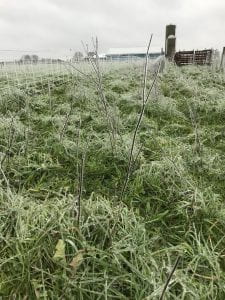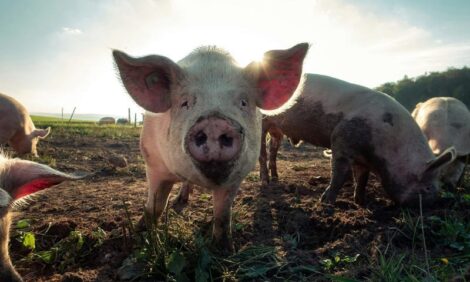



Get ready for winter livestock management
Rain, sleet, snow, ice, and freezing temperatures are on the way
Winter can be a real struggle for two- or four-legged animals. Those of us with two legs can generally put on a warmer coat or go inside to warm up with a cup of something hot, but what can livestock managers do to keep animals healthy and comfortable in the upcoming winter? Being proactive about livestock’s winter needs will reap many more dividends than will responding to a problem after it has developed.
Water
The necessity of a clean and reliable year-round source of water cannot be overemphasized. Novice managers often mistakenly believe that animals can meet water requirements by eating snow or licking ice. With daily water requirements varying from three gallons (sheep) to 14 gallons (beef cattle, more for dairy), one can see that livestock would need to spend every waking hour eating snow to meet their requirements. Ice and snow consumption also lowers body temperature and increases maintenance energy needs, so it should be discouraged.
Water consumption is encouraged when water temperature is 37°F or above. Tank heaters may be required to ensure that water sources do not freeze. Be sure to follow manufacturers’ recommendations to prevent fires and electric shocks or electrocution of livestock. If heaters are not used, unfrozen water should be provided several times a day. Ensuring adequate water intake will encourage optimal health and performance of livestock and help prevent serious conditions such as colic and impaction.
Energy Requirements
Livestock’s maintenance nutritional requirements can increase significantly during cold weather. Requirements increase dramatically if animals become wet and/or there is appreciable wind. Lowest critical environmental temperatures (LCT) for livestock vary according to species and researchers, but 20° or 32°F are often used as the lowest temperature dry livestock can tolerate without additional energy demands to support normal body temperature. Some researchers state the LCT for wet animals is as high as 60°F. Energy requirements for an animal with a healthy and dry winter coat increase by one percent for every degree the wind chill temperature falls below the LCT. Energy requirements for an animal with a wet coat increase by two percent for every degree drop in the wind chill temperature.
Energy can be provided through grain or additional roughage (hay). Roughage is generally preferable due to its feeding safety, lower cost, and greater heat released during digestion. However, if livestock are already consuming their maximum amount of dry matter and/or if forage is low quality, additional nutrients should be provided through concentrated sources such as grains or lick tubs. Frequent small grain feedings are safer than one large daily feeding. Grain supplementation rates will vary with species, so discuss feeding rates with your Extension educator.
Some cold and wet weather fronts can result in predictions that livestock will need close to a 100% increase in energy requirements to help them maintain normal body temperature and functions, but such a large, sudden and short-term increase in energy intake via grain is not healthy for most animals; providing additional high-quality forage is a safer approach. All dietary changes, be they increases or decreases, should be made gradually. Although dietary energy increases are necessary during inclement weather, livestock will fare better if they have sufficient body condition to call upon during times of need.
Blankets can be used daily or as needed to retain body heat for individual animals. This technique is most common for elderly or “hard-keeping” horses, dairy calves, or the occasional pet goat. The portion of the blanket closest to the animal should not become wet.
Feeding
Labor availability is often a major factor in determining how and how often animals are fed in winter. With daily hand feeding, managers will have a better sense of an individual animal’s health and appetite, but hand feeding is labor intensive. Feeding big bales to a group of animals once a day or even less often saves labor, but individual animal health can be overlooked. Animals fed directly on the ground will often waste 50% of their hay, as will animals that are fed more than they can consume at one feeding.
Whatever feeding method is employed, managers must be sure there is adequate bunk or head space so every animal has the opportunity to eat its share of the ration. Dividing animals into groups based on nutritional requirements and feeding groups appropriately will make correct feeding more likely. Pregnant immature animals are an important group to feed separately. Pregnant heifers, doelings, etc. must maintain themselves, finish growing, and grow one or more fetuses. Failing to meet their nutritional needs may result in stunted animals, poor milk production, and weak or dead offspring.
Don’t overlook minerals in the winter. Keep trace mineralized salt available at all times and try to protect it from the elements. Although horses and cattle do well with salt blocks, salt crumbles are best for sheep and goats. Additional macrominerals (Calcium, Phosphorus, Sulfur, Potassium, and Magnesium) may need to be provided depending on how much are present in the ration feedstuffs.
Body Condition
Body condition is also called fat cover or body reserves. It can be assessed in all species through a process called Body Condition Scoring. Livestock managers who body condition score their animals use anatomical landmarks and a five- or nine-point scoring system to objectively measure animals’ fat cover. Thick winter hair coats and fleeces can hide poor body condition, so body condition scoring requires hands-on assessment of animals. Refer to the recommended reference to learn how to body condition score.
Table 1 shows that an animal with a score of one to three on the nine-point scoring system is deemed thin. Scores in the four to six range are average, and scores of five to seven on this scale are recommended for livestock in the winter. This extra body condition will help insulate animals and provide a source of calories during periods of increased energy needs, such as cold snaps. These energy stores also help ensure dams will be able to produce an adequate supply of colostrum and milk for their offspring.
Table 2 reflects that an animal with a score of one on the five-point scoring system is extremely emaciated and an animal with a score of 5 is obese. Body condition scores of livestock in the winter should be three or four on this scale.


Shelter
If a structure is provided, be sure to keep the bedding dry and as clean as possible. Bedding helps insulate animals from the cold ground. However, in bedding soiled with animal wastes, ammonia fumes can build up quickly in the lower 18″ where recumbent animals breathe; irritated respiratory lining is then very susceptible to pneumonia-causing bacteria and viruses. Provide good ventilation so the air seems fresh, but do not permit drafts in the structure. Condensation on windows is evidence that air exchange is inadequate. Again, prevent overcrowding and make sure there is enough space for all animals.
Mud Management
All too often, where there are animals in the winter, there is mud. With good management and planning, the negative environmental and animal health impacts of mud can be minimized. Mud is most commonly found where animals are forced or choose to congregate. Mud makes foot and hoof diseases such as foot rot and thrush more likely and it causes animals to be perpetually chilled, increasing animal discomfort and maintenance energy requirements. The wetness of mud can make parasite survival more likely as well.
Contact your local conservation district for recommendations on how you can prevent mud management problems in your livestock areas. Suggestions may include the development of a sacrifice area and/or use of geotextiles, gravel, tile, gutters, sand, or woodchips to manage wintertime water movement and minimize mud accumulation.
Health Concerns
Your animals may have special health concerns in the winter, especially if they are pregnant. Talk with your veterinarian about the vaccinations, nutritional supplementation, and deworming your animals may need. Also, many animals become infested with species-specific lice in the winter and your veterinarian can advise you how to treat these pests.
Just because it is winter is no reason to overlook animals’ need for exercise to promote muscular and skeletal health. Encourage exercise by varying the location of feeding and watering sites if possible. Exercise will help prevent obesity and overgrown hooves. Hoof care can easily be neglected in the winter, but poor hoof care can lead to several serious health problems. Trim hooves regularly, provide good nutrition, remove manure, and minimize mud for optimal hoof health.
Conclusion
Proactively addressing the special nutritional, environmental and health needs of livestock in the winter will help ensure optimal animal welfare and performance. Preventing problems is more economical than is treating them so in this era of challenging farm profitability, the concept of prevention should never grow cold.


